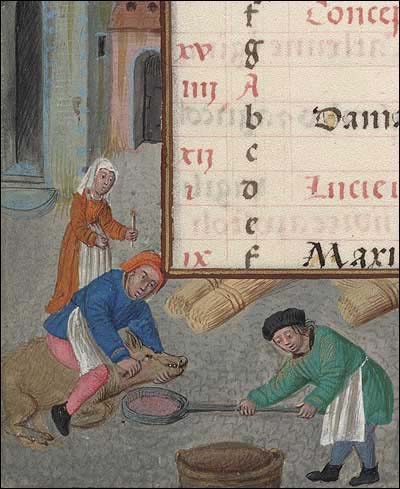Meats and Sausages
Making Sausages
Making sausage is like making a hamburger - the meat is ground, salt, pepper, and the required spices are added and then cooked. If this prepared meat were stuffed into casings, it would become a sausage. People are continuously searching for a “magical recipe” that would create a wonderful sausage, unfortunately, recipes do not make sausages, we do. While various recipes usually get the spotlight (there are thousands online), the technical know-how behind preparing sausages is far more important.

Probably the oldest illustration depicting pig slaughtering in 1420 Europe. A man dressed in blue cuts the throat of a hog with a knife, his helper dressed in green collects the blood, and the lady holding the candle prepares to start the fire in a smokehouse in the back. In practice they will save the best meats for eating, hams will be cured in salt for two weeks and the rest will go for different types of sausages. Blood was collected to make blood sausages, heads, and brains for headcheeses. A pig is a unique animal where nothing is wasted.
The sausage making process
- Meat selection - the taste, binding of ingredients, and texture of the sausage depends on meat selection.
- Curing - important, but often neglected step needed for top quality smoked products,
- Grinding or emulsifying.
- Mixing - or rather forceful kneading is needed to extract meat proteins.
- Stuffing - packing batter into natural or artificial casings.
- Conditioning - brief holding period. Spices release flavor, and the casing becomes drier, resulting in a better color of a smoked product.
- Smoking - (often optional). Flavoring step with hot smoke or flavoring and drying step with cold smoke.
- Cooking - poaching in water or baking in the smokehouse or the oven.
- Cooling - to prevent shriveling of the casing and cross faster the "danger zone" (the temperature range when bacteria multiply rapidly).
- Storing - refrigerator/freezer or, in case of traditional salami, at room temperature.
Why Make Sausages?
Because there aren’t many quality sausages left around. To get a top-quality sausage, you need to:
- find a meat store a trained sausage maker from Europe established and hope that he passed his skills to someone else
- buy quality products online. The best sausages carry the European Certificate of Origin; however, most are available only in Europe. Some products can be purchased online, although at steep prices.
- make sausages yourself
Why Can You Make Better Sausages than a Commercial Producer?
- Because you can select better meat. Good meat makes a good sausage. Commercial producers cannot afford the luxury of choosing the best meats because they produce sausages for profit; they don’t do it for pleasure. Every meat cut, fat, offal meat, and skin, including machine-scraped meat from bones, is utilized to save money and come up with the lowest price. And that translates into higher profits.
- You don’t need to pump meat with water. A terrible but legal practice is pumping water into the meat. Although an enormous amount of sausages are sold in the USA, it is one type of sausage that gets the most credit for sales. And this is an emulsified sausage: hot dog, wiener, frankfurter, or bologna. The meat must be finely chopped in bowl cutters to produce an emulsified paste. As the bowl turns slowly around, a set of sharp round knives placed above cuts meat by rotating thousands of times per minute. The resulting friction will dull the knives and cook the meat, so to protect the equipment, a “certain” amount of crushed ice or icy cold water is introduced to lower the temperature. To prevent this water from leaking, “phosphates” are added, and the water is locked inside the meat. If only 10% of the ice is added, that would be fine; however, “phosphates” can bind even 50% of water. This is why mass-produced frankfurters are made so cheaply; customers buy water without realizing it. Adding water dilutes the flavor of the meat – add water to chicken soup or tea and see the difference. Except for shape, those sausages have nothing in common with frankfurters or other emulsified sausages originally produced from pork and veal in Europe. The difference in taste and flavor is like a difference between the night and the day.
- You don't need to use chemicals. Sausages do not need chemicals; the meat, salt, spices, and time are all that is needed.
- You can create a new recipe at will and are in full control. A hobbyist can create or change a recipe at will. He can improvise and introduce new ingredients that he likes; the number of recipes he can create is limited only by his imagination. A meat plant cannot afford to risk making sausages with blueberries, as supermarkets might hesitate to order them.

















